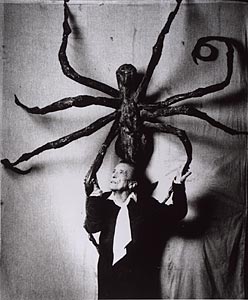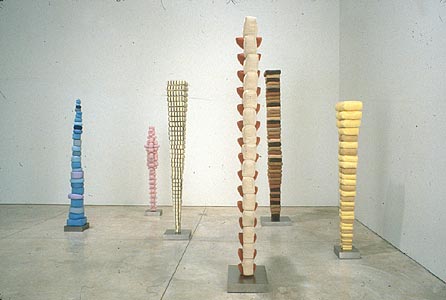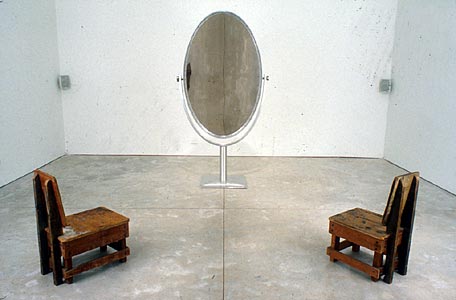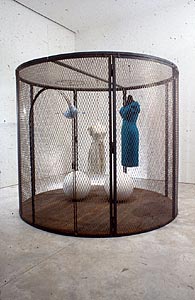|

by Laura
Richard Janku
At
92, Louise Bourgeois is still producing vibrant, large-scale work
that continues themes explored throughout her career. "I
am a long distance runner and a lonely runner, and that's the way
I like it," she said in an interview conducted by
e-mail in June 2002. The ongoing success of Bourgeois' sculptures
lies in their ability to transcend the personal subjectivity of
the maker into collective, objective human experience. And in her
fresh and fearless approach to materials. But it is the personal
origin of the work that fuels its deep emotional impact.
|
|
 |
|
Bourgeois translates
memory and feeling into a universal visceral visual language by
using materials in a way that heightens both their expressive value
and that of the form they describe. She commits herself to no particular
material or—like Gerhard Richter—style of self-expression,
preferring instead to mine all possibilities for the most potent
combination. Working in everything from fabric to bronze, she calls
forth the medium's shamanistic quality and uses it to construct
elemental forms that balance gracefully between rawness and restraint.
Despite the specificity of many titles, the work is more literary
than literal, invoking a pantheon of mythologic and psychologic
symbolism.
|
|
 |
|
Her
recent solo show—the first in New York since 1994—at Cheim
& Read featured large narrative sculptural works comprised of
multiple media. Figures of stitched fabric recall her earlier "personnages."
But the newer pieces are soft, doll-like compared to the totemic wood
and bronze pieces from the 40s. New and old share Bourgeois' obsessive
processing of the past and, as in all of her work, this exorcism functions
as springboard to many other issues lodged in her consciousness: femininity,
self-image, sexuality, mortality. |
|
Born in 1911
in Paris, Bourgeois was involved at an early age in her parent's
business. At fifteen she began working in their successful tapestry
restoration studio. However, at that point she was already painfully
party to the marital drama epitomized by her father's philandering
and her mother's passivity. She fled what she describes as this
"nest of nuts" to study math at the Sorbonne which, at
twenty-five, she gave up for art. In 1938, newly married to the
American art historian Robert Goldwater, Bourgeois arrived in New
York. Rather than taking up the common modern cause, the anarchic
path of her work became a way to affirm herself and her past through
differentiation from the status quo.
|
|
 |
|
Having
worked for so many decades in solitude, Bourgeois' international recognition
over the last two decades, beginning with her first museum show at
MoMa in 1982, has done little to change her course. Her commitment
to the personal throughout the formal reduction of Modernism and Minimalism
made her a galvanizing force for the post modern subjectivist movement.
Yet hers was not a reaction to contemporary movements, but a force
that began with the Surrealists with whom she consorted in Montparnasse
in the 30s. |
|
The vindication
of belated acclaim is surely sweet, but for Bourgeois it is incidental:
"I don't need
success. It's not what motivates me. Though success is sexy."
And success in the art world is not so easily opted out of if one
wants to continue producing work for public consumption. It is also
demanding, especially for someone so entrenched in her own life.
The recognition bears public responsibility—if only to refute
inaccuracies of interpretation—and Bourgeois vacillates between
candor and the caginess of obligation. It seems that the confessional
approach she takes to certain parts of her past is a tithe she pays
for the protection of other domains. Though a mother herself, she
speaks very little of her own family, as if to shield them from
prying eyes. Or perhaps, her work is purely autobiographical and
it does encompass her children to the extent that they are a part
of her. In some ways they are her most successful sculptures of
all.
|
|
 |
|
Bourgeois'
new works are haunting. They range from the aggressive emotion fully
figurated in Rejection, Hysterical, and We Love You
to the more familiar psychosexual symbolism of abstracted works like
Cell XIII and Untitled. These vivid three-dimensional
tableaux created from fabric sculpture share the complex and explicit
narrative of traditional tapestry. Other untitled pieces resemble
stacks of children's building blocks constructed from fragments of
actual tapestry. But the artist is resistant to neat assumptions about
her work coming full circle with her past. "The
idea of restoration is deep within me." However, she
is quick to refuse textiles any privilege, despite her beginnings
in tapestry: "I am not interested in
any one material. The materials are just materials, and they are there
to serve me." And some serve certain ideas better
than others. Cheim & Read describe a shift in message via materials:
"The images of severing and fragmentation in the earlier periods
of Bourgeois' work associated with the father is replaced in these
works by the activity of binding and holding together, associated
with the mother. Stitching becomes a form of healing. Fragments become
ordered and unified, edges become softer. The integration of the parts
represents a desire for restoration, reparation and reconciliation." |
|
 |
|
Despite her
age, the physical aspect of creating art remains at the core of
Bourgeois' ability to reconcile past with present: "The role
of my own body is crucial. There is anxiety at the beginning of
the process, and hopefully in the end the tension in the body is
released." Creation conflates emotion and action, offering
new energy and perspective: "Art should help you to be able
to deal with other people. It should give you insights into yourself."
But it is an ongoing struggle, one in which the artist's stamina
and tenacity is recorded by decades of powerful visual testament.
"I want to be at peace with myself
and others. And that's hard." Assuring-happily for
the viewing public-that her process, like Penelope's, will continue
indefinitely.
|